| Home > RX-7 > My RX-7 > Project Tina > Project Tina, 2009: Boost Controller, Fuel Tank Fab, Transmission Destruction, TII Transmission |
| Home > RX-7 > My RX-7 > Project Tina > Project Tina, 2009: Boost Controller, Fuel Tank Fab, Transmission Destruction, TII Transmission |
Welding the baffles into place was a bit of bitch due to limited space and odd angles. I had to get a short cap for the back of my torch and even then it was quite frustrating. They did warp a bit during welding as you can see because the heat got away from me a bit. Well it would have been nice to keep them straight, the warp is only aesthetic and soon to be closed inside the tank never to be seen again when the top is welded into place.
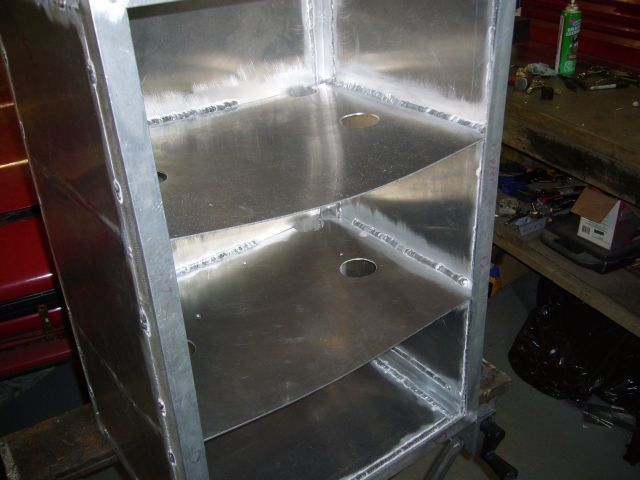
Let's take a quick momentary break from the tank for a quick story. This was the first year in a while where I was able to drive the car in the early spring. The winter ended quickly enough that I actually took the car out of the garage in late March, replaced the rear calipers (one was leaking) and then had it on the road. It was about a month later (just before the Easter weekend) that I blew the first transmission.
One afternoon I was running across the city to get to the post office before 5PM. One of the main cross streets turns into an expressway so the speed limit goes from 60 (KM/H) to 100. As the light turned green I was stuck behind some douche in a Camry that didn't seem to understand that going 50 KM/H in the left lane of a 100 zone is a bad thing. With the big diesel riding my butt so close I could see the herpes on the driver's lips, I signalled to switch lanes.
Of course, just as I was pulling out, the guy driving the diesel penis-extension behind me thought it would be a good idea to move lanes as well and punch his throttle. I'm thinking "WTF?". So I dropped it into third, went WOT and unleashed the beast. I had very little room because my off ramp was the next one otherwise I would have been a little more responsible. Missing exits also means a round trip through prime traffic jam area.
Coming up on about 5500 RPM there was a noise that was a combination grinding-clunking-banging, at which point the car stopped accelerating. I tried 3rd again...no dice. Nothing in 2nd either. Finding 4th, I took my ramp and luckily had all green lights to a local parking lot, where a tow truck met me and towed me home.
I had a spare transmission which I quickly swapped in place the following weekend, then pulled apart the blown unit a few days later. The damage was quite impressive:
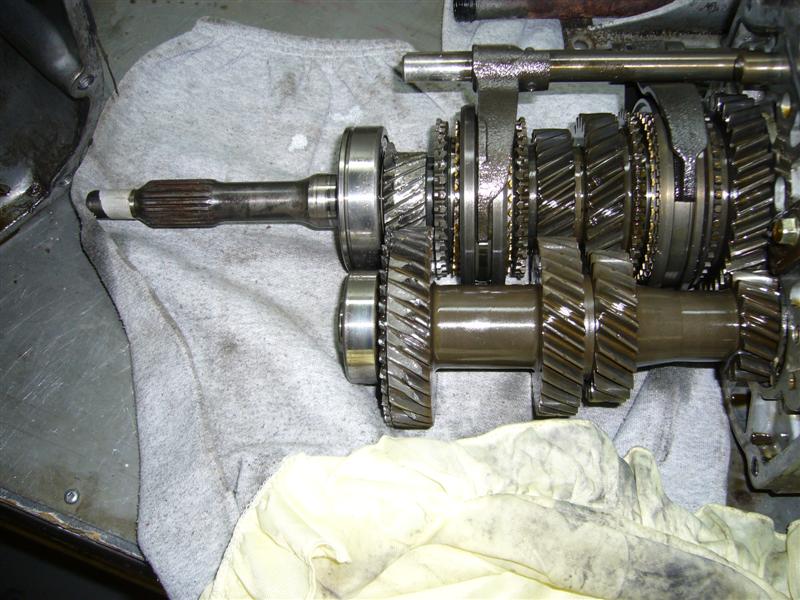
Looks like I stripped the input shaft and the cluster shaft input gear. I was not entirely surprised as the transmission did pick up a bit of a whine after an evening at the track last year, and some more tuning had really smoothed out the fuel map and improved the midrange of the car considerably. It was just a matter of time before the NA transmission would give up on life.
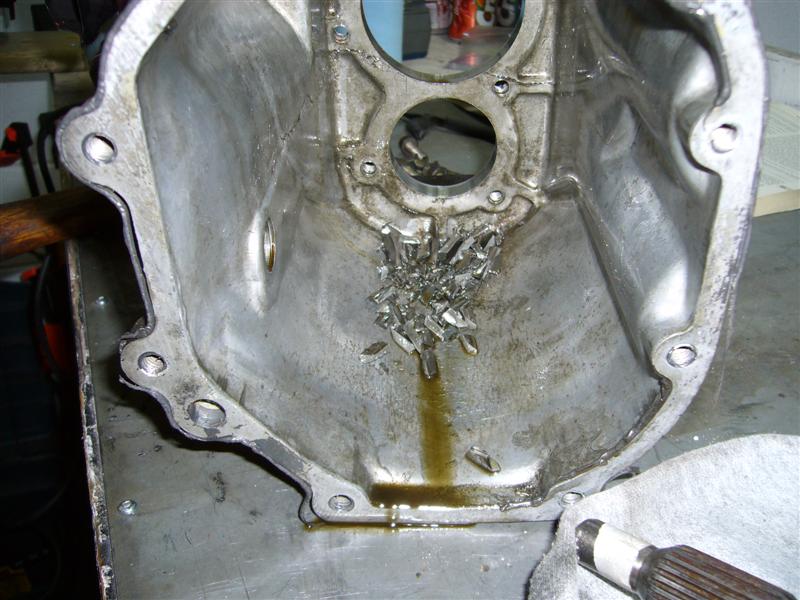
So with the transmission replaced, I continued to drive the car for the rest of the summer.
Back to the tank, it was time to start working on the fuel sump. I first welded up the section of the outer seam that would be covered by the sump and then measured the area. The vertical plate you see in the bottom right of the image is the rear vertical section of the sump. It was tacked into place after I decided how big of a sump I wanted. The four circles within the sump area will allow fuel from the main tank into the sump. After reading some tank fabrication articles, it seems that many builders just drill large holes instead of cutting the entire area out. The thought is that the metal lip left by the holes will help prevent fuel from sloshing out of the sump. This seemed like a good idea to me.
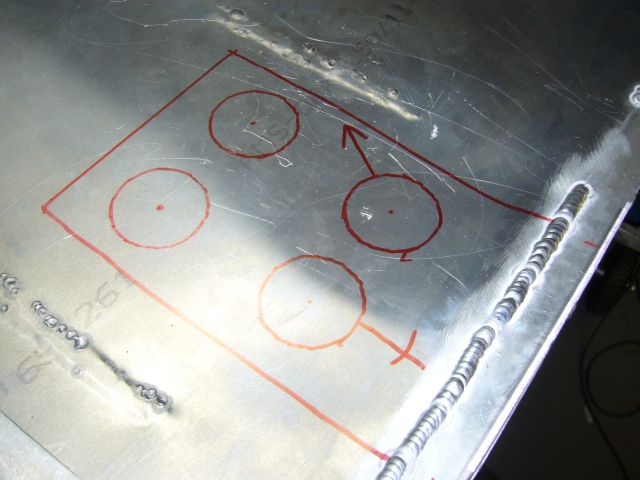
Next, I just drilled the holes out with a hole saw.
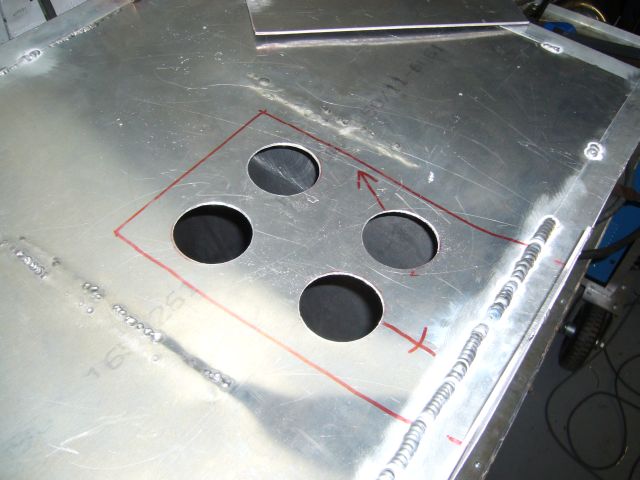
The bottom half of the sump was then cut and test fitted.
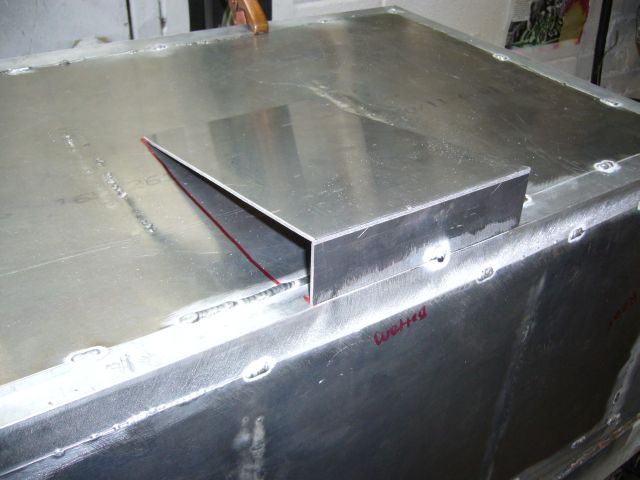
After tacking the bottom of the sump, I made paper templates for each side and then cut each side individually. I had to do this because the bottom of the tank had warped from all the welding and was no longer quite straight. Actually, quite a lot of the tank had warped and it was no longer dimensionally accurate. This happened despite welding in short bursts, controlling heat and alternating seams. The whole bottom sort of bowed inwards. I can't say that I'm very happy with the tank because of this and am considering trying to make another. If I do take that approach, I will simply have a metal shop bend up the sheet metal in a box so that all I will have to do is weld in the baffles, attach the sides, and add the sump.
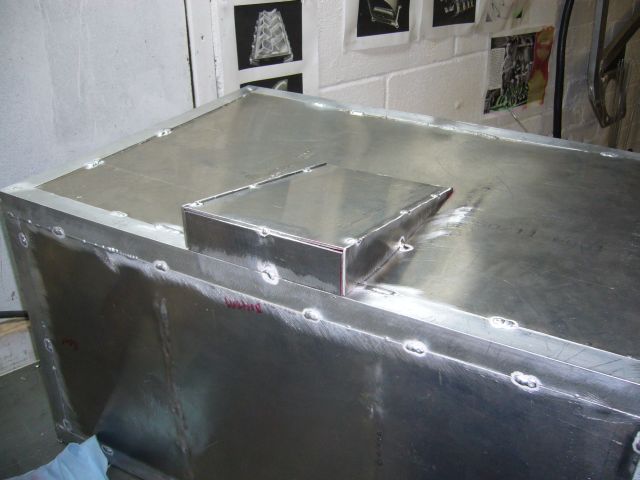
Here's a view from inside the tank at the sump, just before the top was welded in place. You can see the internal seams of the frame at the top of the image, and the baffles at either side.
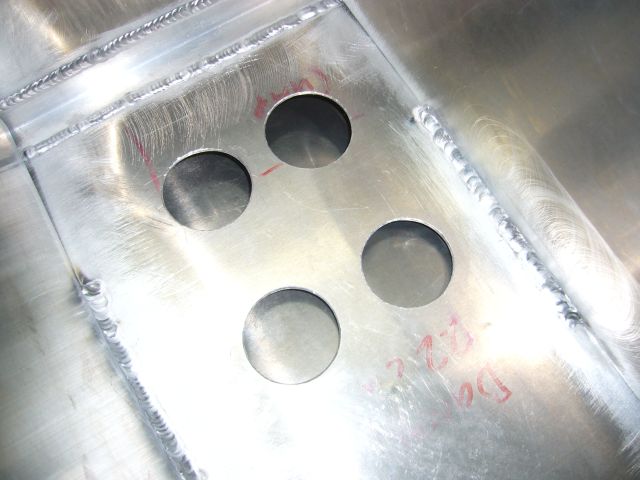
The sump has two fuel fittings; an outlet to the pump and then the inlet return fitting (from the pressure regulator). Before they can be welded into place, holes must be drilled. I used a step drill to make the odd sized holes required by the weld-in AN flares.
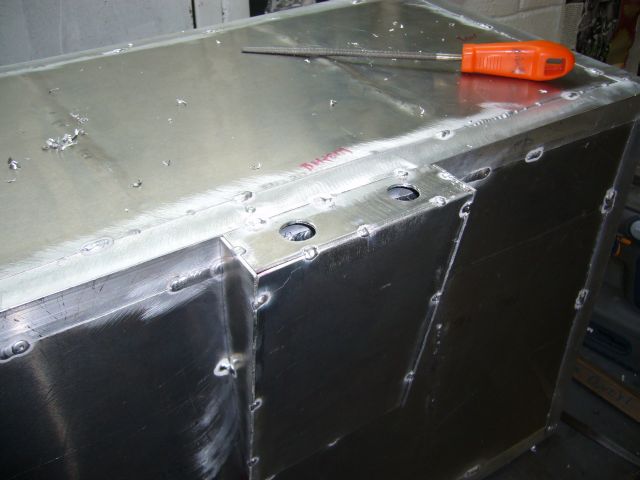
The fuel pump feed fitting is a -8 flare while the return to the tank is a -6 flare. The feed to the pump needs to be larger is it is on the vacuum side of the pump and thus subject to negative pressure. Having too small a hose will drastically increase the effort required by the pump to pull fuel and thus limit fuel flow.
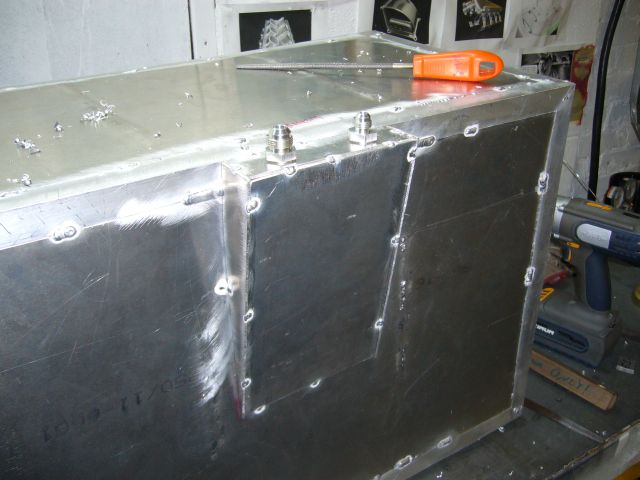
It was finally time to fully weld the tank! This is where I finally decided that building a frame and enclosing it is the [i]wrong[/i] way to make a fuel tank. The primary reason is that it created about four times the welding then would have been needed by directly welding the panels together. After about 6 or so hours behind the torch the tank was fully welded, I was a few bottles of shielding gas poorer, a bit sunburned and sick of working on this stupid tank.
There was, however, a certain odd satisfaction in filling the tank up with water as a leak test.
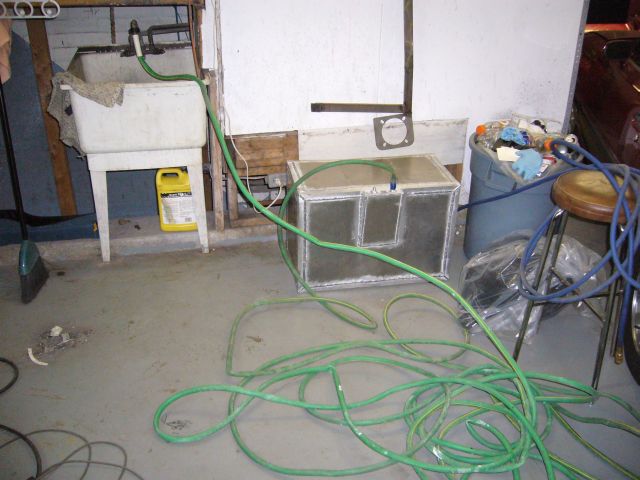
Sadly, there were a few leaks. I guess it was bound to happen, so they were marked for later repair.
So the tank (mostly) holds water, but can you spot the issue with this picture? That's right...1 litre of water is not heavy (about 2.2 LBs, actually). However, the 110 litres of water that filled this tank certainly was! The size and weight of the tank required two people to lift it up to the sink where it took 10 minutes to drain as air was blown in with the compressor.
At this point I was rather sick of working on the fuel tank, so the car offered me a distraction which realigned my priorities regarding what work needs to be done.
Late in the summer, I finally got around to turning up the boost. At 16 PSI it feels like there is 100HP more to play with, but it only took 3 or so runs before the "new" transmission started making some unhappy noises. I continued to drive the car just being conscious that the transmission could leave me at the side of the road at moment. As it turns out, that is exactly what happened in mid November.
One afternoon, I was out for a drive with some friends. 10 minutes out of the city we had a clear road ahead but were stuck behind a truck pulling a trailer at half the speed limit. The car ahead of me pulled out and passed, I followed by dropping it to 3rd and putting the fun pedal down. Literally exactly as ocurred the first time, the transmission tore itself apart as the engine just crossed 5,000 RPM at 14 PSI. I was treated so the same shattering-crunching-grinding-breaking noise as before, and had no gears but forth.
I was able to limp home in 4th, which was a lot of fun as I happened to hit every freaking red light as I drove through the city from the highway to my house. It was scary how during the trip the transmission started crushing rocks, yet grew more quiet as the parts self machined...
As it was so late in the season and I figured we would be seeing snow at any point (oh, how wrong I was...we only just now received snow on December the 29th), I decided to just park the car in my shop and start pulling out the dead transmission for replacement. A few weeks prior I had purchased a TII transmission locally, knowing I would be needing a replacement. While I considered several different transmission options, eventually leaning towards the T5, the price of the TII transmission was hard to beat and sometimes there is something said for just bolting something in place. While the TII unit was out at a local transmission shop getting being rebuilt (new seals, bearings, syncros) I was preparing for its installation.
First, I pulled out the 2nd blown NA transmission. Check out this flywheel. I guess this is what happens when you drive home 50KM using only 4th gear on a copper puck-style clutch. Both the flywheel and pressure plate (not to mention the disc) are totalled.
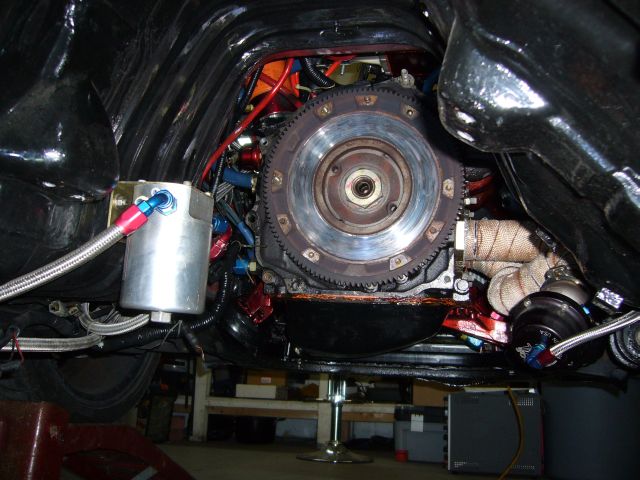
Well screw me sideways with a sandy pickle, the fuel filter is in the way of the much larger TII transmission. Or the transmission is in the way of the fuel filter, either way it sucks.
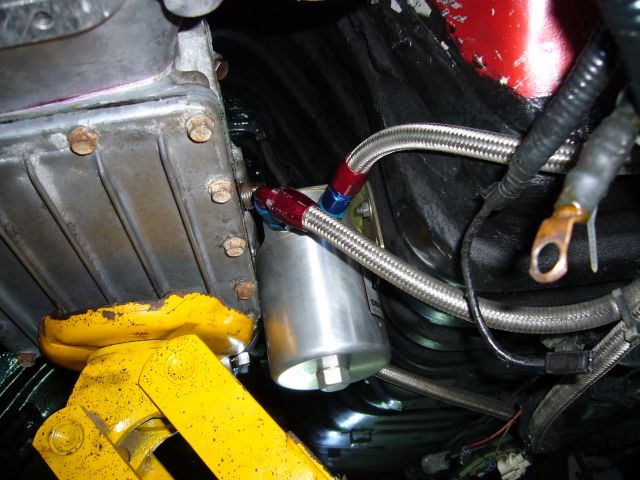
Oh, on second thought there is plenty of room for the fuel filter after the transmission is installed.
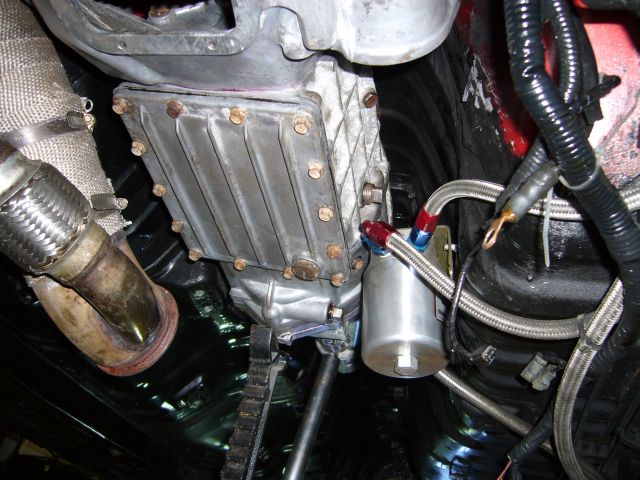
After using a torch to warm up the flywheel nut enough to release the red Loctite, the impact wrench made quick work of the nut. After that the flywheel was removed, followed by the pilot bearing and seals. While the pilot bearing and rear seal were only a few years old, it makes sense to replace them anytime the transmission is pulled just because of the pain in the ass factor of actually getting to them.
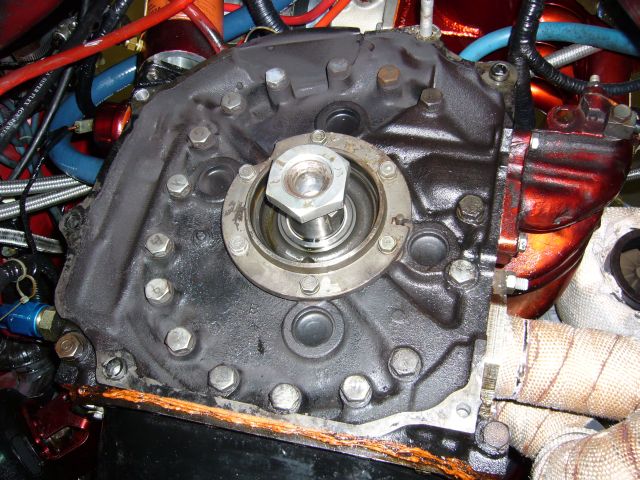
Thanks to Danny's Transmission in London (Ontario) I had a fully rebuilt TII transmission ready to go. Before it could go into the car I wanted to paint the bellhousing to match the rest of the engine. So the first step was to give it a quick polish using a wire wheel on the drill.
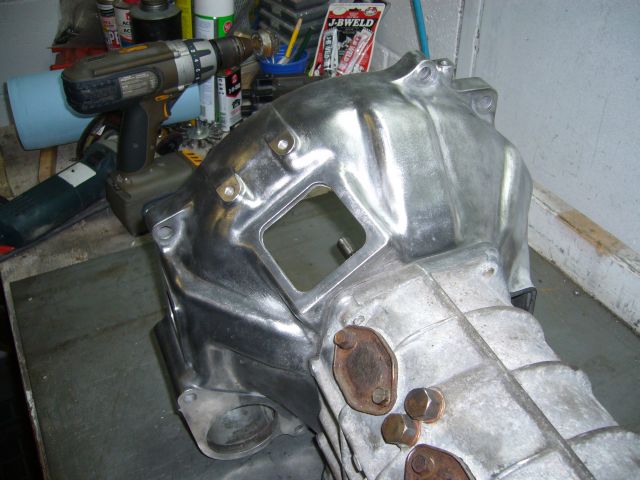
After that, 3 coats of MetalCast red and the bellhousing had a finish matching the rest of my engine bay. I did briefly consider painting the rest of the transmission silver but figured that it would get all scratched up during installation and it is under the car anyway, mostly covered by the big exhaust heat shield.
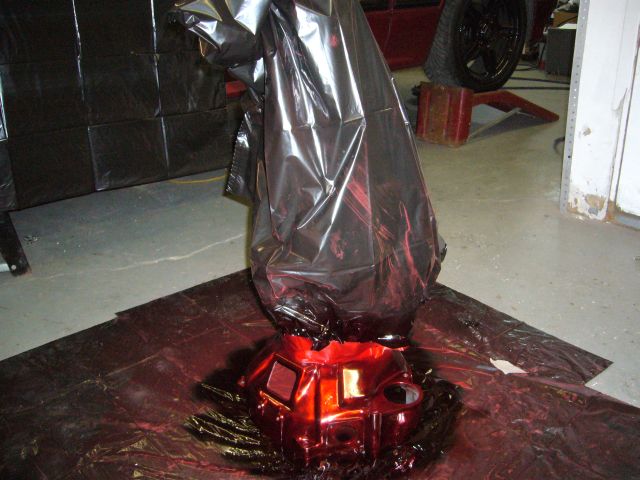
I think that's it for now. I have since installed a TII flywheel and new clutch to match. The transmission itself bolted into the car last night and tonight I am planning on taking care of the little things which are related (clutch slave, extending the wiring, shifter reinstallation, etc.).
Now I do have some more plans for the rest of the winter. I need to fix some small issues with the car that have been bothering me. A few little oil leaks, stock engine mounts and some other engine bay clutter has become more of an annoyance the more I drive the car. The front cover also needs to be pulled for installation of a TII oil pump so while I have that off, I will also be making a few adjustments to it after I (gasp!!) remove the metering oil pump. Finally, I have an LSD rear end sitting in the corner of the shop just waiting to be installed, and of course, the bloody fuel tank will actually need to be mounted on the car (as soon as I figure out how).